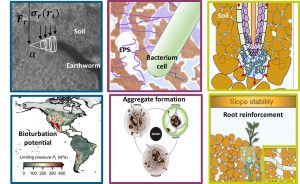Project No. 2460
PRIORITY PROJECT
Primary Supervisor
Dr Siul Ruiz – University of Southampton
Co-Supervisor(s)
Dr Katherine Williams – University of Portsmouth
Prof Tiina Roose – University of Southampton
Summary
Soil biophysical interactions play a critical role in facilitating water flow and retention, aeration, and nutrient transport, which aid in maintaining habitats for soil biota.
Climate change and land misuse act to impede biological activity. The project is set out to better understand the interplay between biological agents and soil physical behavior by exploring fundamental processes at pore scales and quantifying how they might play a role at field, infrastructure and global scales. Soil biological agents range in size from microbes, fungi, to earthworms, and plant roots from crops and trees. Therefore, understanding physical constraints and processes (i.e. mechanics and mass transport) relevant to their environmental scales is of critical importance for maintaining their habitats. By understanding these soil biophysical interactions from fundamental principles, we can gain a better understanding of their environmental limitations (i.e. mechanical, fluid, chemical, etc.) and how to better exploit these processes to enhance carbon storage, implement regenerative agriculture in regions that support broad forms of soil bioturbation, promote root growth and broader microbial biodiversity in regions at risk of washout, and leverage the biomechanical potential of root growth to reclaim compacted and drought impacted land. This work will make use of image based mathematical or statistical modeling ranging from pore scale processes to global maps based on fundamental solid mechanics, multi-phase fluid dynamics, and mass transport. This work will be carried out in collaboration with state of the art synchrotron and imaging facilities such as the Diamond Light Source in the UK, Paul Scherrer Institute in Switzerland, and the Sirius light source in Brazil in order to obtain pore scale insitu measurements of soil structure, chemical signatures, and moisture distributions. This work will guide informed sustainable policy.

